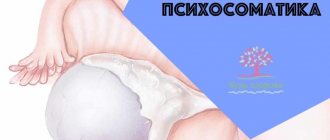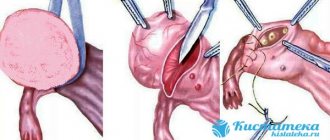Can an ovarian cyst cause stomach pain?
Pain in the lower abdomen is the most important symptom of a growing ovarian cyst. True, by themselves they do not mean anything, since they can be a symptom of any diseases of the genitourinary system and inflammatory processes.
However, it is worth checking with a gynecologist if abdominal pain is accompanied by:
- Radiating (referred) pain in the lower back, rectum, lateral or upper abdomen
- Menstrual irregularities, delays or absence of menstruation
- Bloody discharge between periods
- Bloating
- Bowel or bladder problems
- Pain during intercourse
If such symptoms appear, a woman should immediately make an appointment with a gynecologist and have an ultrasound of the pelvic organs.
Can there be a delay in menstruation with an ovarian cyst?
Delayed menstruation is also one of the main symptoms of ovarian cysts. Associated symptoms for the diagnosis of ovarian cyst can be found in the previous section of the article.
In general, women often experience irregular menstrual cycles, which can be due to many reasons. Typically the cycle length is from 21 to 35 days. It is believed that a delay of up to 5 days is not a cause for concern; beyond this time, it is already a recommendation to consult your gynecologist.
Very often, menstrual irregularities and delayed menstruation are caused by functional ovarian cysts (follicular and corpus luteum cysts). The fact is that the cells that make up these cysts produce the hormone progesterone. If it is produced in too large quantities, then its effect on the body in the second phase of the cycle is prolonged until menstruation is delayed (the hormonal background cannot ensure timely rejection of the endometrium) or, on the contrary, bleeding (due to uneven rejection of the endometrium of the uterus).
Often, delays in menstruation begin to occur several months before the appearance of the cyst, when the pathological process of formation has already begun. Therefore, gynecologists often predict the early detection of an ovarian cyst if menstruation begins to be delayed for no apparent reason or health problem. And the delays do not have to be long - 7 days are already considered a dangerous signal.
That is why, at the slightest suspicion, it would be a good idea to undergo a gynecological examination. Do not be afraid if your doctor recommends surgical removal of an ovarian cyst. It is better to do this in a timely manner using a gentle laparoscopy method and preserve the functionality of the ovary and reproductive function than to ignore the problem and develop health problems, the least of which will be infertility.
Can there be a false positive pregnancy test with an ovarian cyst?
Gynecologists answer this question in the affirmative - an ovarian cyst can indeed be the cause of a positive test in the absence of pregnancy. But usually the second stripe in the test appears weakly, not bright enough.
However, if you understand the problem, it usually turns out that this result is not caused by a cyst, but by a cystoma - a hormonally active tumor on the ovary. Ultrasound cannot distinguish a cyst from a cystoma, which produces hormones that may well distort the test result, so the doctor who performed the ultrasound examination calls any large cavity formation a cystic formation in the conclusion. And in common parlance it is most often called simply a cyst.
However, if an ultrasound reveals a tumor, and against this background, a pregnancy test after a missed period shows a positive result, this is a serious indicator that the woman should undergo additional examinations to rule out suspicion of a malignant tumor.
In addition to the cystoma, other factors can affect an incorrect test result:
- Incorrect application of the test
- Using test that has passed its expiration date, is damaged in packaging, or has been improperly stored
- Ectopic pregnancy
- Irregular menstrual cycle (if there is no set period between periods, then you should not seriously consider using the test as a method of determining pregnancy)
- Use of contraceptives
- Ovarian dysfunction
Sports activities for the treatment of cysts
Although massage and sports activities are often contraindicated for cystic formations in the appendages, in some cases they are included in the course of treatment. Thus, for some types of pathologies, therapeutic massage of the vagina or special sports complexes are prescribed. All this allows you to eliminate congestion in the female genital organs. Often, cystic tumors appear precisely because of poor blood supply. Therefore, moderate exercise is an excellent preventative measure for neoplasms, and can also be included in complex anticystic therapy. So, even by slightly inflating and retracting the abdomen, you can put your muscles in order. Such loads lead to compression and straightening of organs. This improves blood pumping processes and can speed up the process of resorption of ovarian cysts.
Important! Breathing exercises will improve the results. The advantage of this physiotherapeutic treatment method is that it can be used even at work.
With small formations in the appendages, it is allowed to perform simple abdominal exercises, squats and even run. All classes should be measured and unhurried. Yoga helps many women get rid of cystic formations.
In conclusion, it must be said that any neoplasms in the ovaries require careful attention and lifestyle adjustments. However, it is not always necessary to completely abandon physical activity. To find out whether sports activities are allowed for such a pathology, you should consult with your doctor.
Can you have sex with an ovarian cyst?
There is no clear answer to the question whether you can have sex with an ovarian cyst or not. It all depends on the individual case.
Basically, a cyst is not an obstacle to a full sexual life. But with such a diagnosis, it is necessary to exclude physical stress on the abs, so a woman should avoid sexual positions in which she will strain her abdominal muscles. The load on the abdominal muscles is fraught with rupture or torsion of the cyst. Intense intimate marathons with significant overall physical load on a woman’s body are also highly undesirable.
However, there are cases when sex with an ovarian cyst is contraindicated:
- If the cyst is large (about 10 cm)
- If sexual intercourse causes pain (to avoid cyst rupture, do not ignore this pain)
If a patient is undergoing surgery to remove an ovarian cyst, the woman may also wonder: is it possible to soon return to an active sexual life with an ovarian cyst removed? Provided the operation is successfully performed and the test results are good after it, the patient can begin intimate life again within a month.
By the way, an interesting fact: scientists have proven that regular sex, which brings pleasure to a woman, has a positive effect on the hormonal balance in her body, and as a result helps prevent the formation of ovarian cysts.
Treatment options
After a thorough diagnosis, the doctor will prescribe treatment, which can be of two types: surgery and drug therapy. The first method is required in cases where the cyst has ruptured or twisted, and in the presence of a malignant tumor. Today it is generally accepted to use laparoscopy. Surgical methods may also include:
- Cystectomy – complete removal of the cyst.
- Ovariectomy – removal of the ovary.
- Adnexectomy - cutting out the appendages from the uterus.
- Ovarian biopsy - removal of two ovaries. This operation is prescribed when cancer pathology is diagnosed.
The medicinal method is more common. The doctor prescribes painkillers and birth control pills. This will help avoid the development of new cystic formations.
Medicines that are used in conservative treatment include progesterone (Duphaston). The hormone presented prevents the growth of the cyst. Therapy usually takes at least six months. Doctors note many cases where medications turned out to be useless.
The doctor also prescribes pills that help normalize hormonal levels. Each person should take them differently, depending on the results of the blood test. Do not begin self-treatment with these drugs under any circumstances. Otherwise, you risk developing complications.
Let's consider the most popular method of surgical intervention for ovarian cysts.
Laparoscopy. This method of surgery is divided into two types:
- Diagnostic.
- Medicinal.
Laparoscopy is performed much more often in comparison with other surgical treatment methods. The operation avoids making an incision in the abdominal cavity. The surgeon makes several punctures near the navel. He inserts the endoscope through the holes made. The camera on this instrument transmits the image to the screen, which allows the operation to be performed with minimal cosmetic effect, eliminating surgical errors.
Laparoscopy can last from 20 to 40 minutes, which directly depends on the volume of the tumor. Basically, the presented method is prescribed for the first phase of menstruation. After a successful operation, the patient is released within a day. You are allowed to return to household chores after 3 days.
Can I exercise if I have an ovarian cyst?
For girls who carefully monitor their physical fitness, the question of whether it is possible to continue doing exercises with an ovarian cyst is especially relevant. The diagnosis of an ovarian cyst causes certain restrictions regarding intense exercise, as well as certain exercises and sports. Much also depends on the complexity of the disease.
Doctors advise completely eliminating physical activity if the cyst is accompanied by inflammatory processes. In this case, you can start exercising only after a course of treatment, gradually increasing the load.
Some types of exercises can lead to rupture of even a small cyst, so for any type of ovarian cyst, stress on the abdominal muscles is prohibited. Also prohibited are athletics, intense running and strength training - anything that can cause sudden movements and cramps in the lower abdomen. Apoplexy (tissue rupture) can be triggered by any sudden movement or the slightest injury - a fall, jump, somersault, etc.
The following exercises can lead to rupture and torsion of the cyst:
- Jumping
- Swing your legs
- Lunges
- Squats
- Press swing
- Sprint running
- Lifting barbells or heavy dumbbells
- Sudden turns or bends of the body
Jogging and cardio training can be replaced by race walking. This lighter version of running is completely safe.
In any case, before starting sports training with a diagnosis of an ovarian cyst, it is better to first consult with a doctor who will help you choose the optimal load and type of sport that will not harm you.
Sports and exercise after laparoscopy
In some cases, with an advanced, complicated form of gynecological pathology, laparotomy is performed. This operation involves surgery using a special laparoscope device, which is equipped with a camera. It is introduced into the abdominal cavity through small punctures filled with carbon dioxide.
Important! Compared to conventional classical surgery, this method is less traumatic and safer. The procedure takes no more than an hour. After laparoscopy, the woman returns to her normal life within a few days.
Can I do sports and exercise after laparotomy? Despite the rapid recovery, the absence of complications, a return to normal life and sports is possible only in the absence of contraindications. Physical activity and activity should be treated with great caution. You can move carefully and walk slowly almost two to three hours after laparoscopy. Sitting is allowed after 24-26 hours. You can walk actively no earlier than after three to four days. Sutures are removed on the 7-8th day after surgery. Any physical activity should be completely avoided for one month. Hard work, heavy lifting, sudden movements, and workouts that cause overstrain of the abdominal muscles are contraindicated. During the month, intimate life is also prohibited.
According to the doctor's indications, you can begin minimal exercise to speed up recovery five to six weeks after laparotomy. You should start with short, slow walking over short distances. Increase the pace, duration, and intensity level of your workouts gradually.
Important! To speed up the recovery process after laparoscopy, experts recommend combining light physical activity with breathing exercises.
Before introducing a new set of exercises after surgery, consult a gynecologist. We recommend doing physical education, gymnastics, and exercises under the supervision of a professional trainer. You can start normal exercise and physical activity 1.5-2 months after laparoscopy.
Is it possible to lead a normal lifestyle with an ovarian cyst?
The diagnosis of an ovarian cyst does not impose strict restrictions on the usual lifestyle of most patients. However, there are still a number of contraindications.
Contraindications for ovarian cysts:
- Visiting a sauna or steam bath
- Taking a hot bath
- Massage, wraps and other spa treatments
- Various physiotherapeutic procedures (if they are not prescribed by a gynecologist)
- Tanning in direct sunlight
- Intense sports
- Self-medication
Is it possible to get pregnant with an ovarian cyst?
The best option is to plan to conceive a child in advance, having previously undergone all gynecological examinations that will detect a cyst.
In the case of acute pathology (rupture or torsion of an ovarian cyst) requiring radical surgical intervention, after the operation there may be difficulties with conception if adhesions occur in the fallopian tubes (as a complication after surgery) or one damaged ovary has to be removed. However, if the operation is planned and carried out in a timely manner, then problems with conception usually do not arise.
If the patient has a functional cyst, then it is not an obstacle to conception and pregnancy. Moreover, often such cysts, without drug treatment, resolve on their own during pregnancy, when the body rearranges its hormonal levels. But it is still better to be constantly monitored by a gynecologist.
There are cases when an ovarian cyst is discovered in a pregnant girl. If it is small in size and does not bother the woman, then the patient is simply observed.
Polycystic disease and sports
Polycystic disease is a gynecological pathology characterized by multiple development of cysts on one or both ovaries. Sports activities and moderate systematic training are very often an addition to drug treatment. Recommended exercises for polycystic disease:
- slow walking; easy, not fast running;
- exercise therapy;
- yoga;
- breathing exercises;
- short training sessions that promote the development and strengthening of the muscular structures of the pelvic and abdominal cavity.
Classes are combined with breathing techniques, swimming, jogging, and long walks in the fresh air. Treatment, consisting of drug therapy and exercise therapy, reduces the risk of complications and reduces the likelihood of relapses.











